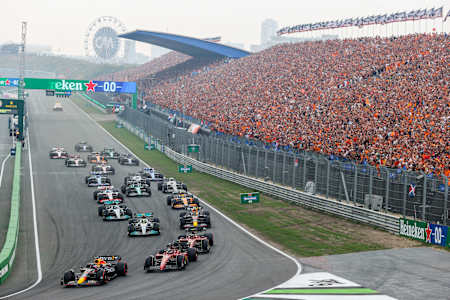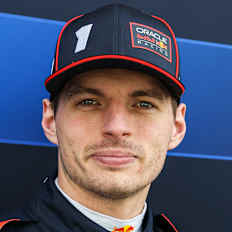Red Bull Motorsports

F1
The ultimate Zandvoort F1 circuit guide
Formula One returned to the Netherlands in 2021, racing at a circuit that rivals Silverstone, Monza and Spa-Francorchamps for history. Here’s the full guide to the new-and-improved Zandvoort.
After a 36-year hiatus, the much-loved Dutch circuit returned to the F1 calendar in 2021 for the Dutch Grand Prix. Though very much remodelled to push the fastest cars and drivers on the planet to the absolute limit, the Zandvoort circuit in its modern guise retains some of the old-school charm that made it famous and continues to have a special place in the heart of racing fans everywhere.
01
A bit of history
Like its British counterpart and F1 mainstay, Silverstone, Zandvoort was borne out of enthusiasm for all things motorsports following the Second World War, and both tracks were inaugurated in the same year: 1948. Between the years of 1952 and 1985, Zandvoort held 30 Grands Prix in total, making it one of the most used in the history of the sport. In that period there were only four times, in 1954, 1956, 1957 and 1972, that the circuit was not used for the Dutch Grand Prix.
The winners on the circuit read like a who's who of four-wheel motorsport. Italy's Alberto Ascari was the first winner of an F1-accredited race on the course in 1952. World champions such as Juan Manuel Fangio, Graham Hill, Jim Clark, Jackie Stewart, Niki Lauda, James Hunt, Nelson Piquet and Alain Prost have also won in Zandvoort. Clark is the most successful driver in the history of the Dutch GP with four victories.
As mentioned above, Zandvoort returned to the F1 calendar in 2021. Fittingly, the chequered flag greeted Dutch national Max Verstappen first, a winning feat he repeated in 2022.

1 min
Max Reveals His Special Dutch Grand Prix Helmet
Once again, Max will drive with a special edition helmet during the 2023 Dutch Grand Prix.
02
Why is Zandvoort so special?
Zandvoort isn't based on an airfield like so many old racing circuits of its ilk. Instead, it was created from a mixture of permanent track and public roads flowing around the sand dunes of Zandvoort. Although it's changed dramatically through the years as F1 itself has had to modernise, ‘pretty insane’, ‘crazy’ and ‘old-school’ remain among the descriptions from slightly incredulous drivers who’ve taken on the modern circuit.
03
The modern Zandvoort

2 min
First laps on the remade 2020 Zandvoort circuit
Max Verstappen gets his first taste of the newly renovated 2020 Zandvoort circuit in the Netherlands.
Zandvoort as it is today is based on a track configuration that came into being at the start of this millennium. The first half of the modern circuit retains all the old corners of the original 1948 course. The second half of the course, which came into operation in 1999, saw the old southern part of the circuit removed and the circuit being rerouted inland instead. Only the last corner that leads into the start/finish straight remains from the 1948 circuit in that second half of the course.
04
Race stats
- Circuit length: 4,259 kilometres
- Number of corners: 14
- Laps: 72
- DRS areas: 2
- Fastest Lap: 1:08.885 by Max Verstappen during Dutch Grand Prix qualifying in 2021
05
Zandvoort's most famous corners
Tarzan
Tarzan is the first corner at Zandvoort. Why this famous corner at Zandvoort is named Tarzan is shrouded in mystery, spectators love to speculate wildly at the origin of the name. As with most corners in Formula 1 history, Tarzan owes much of its fame to its difficulty. Tarzan, specifically, is unique because it is a wide bend, making it possible to overtake during a cornering manoeuvre. Zandvoort is not the easiest place to overtake, so Tarzan is the place to be to do or see some ‘do-or-die’ overtaking moments.
Gerlach
Pulling out of the hairpin, drivers face a left kink followed by a sharper right that is Gerlach. It’s a corner boasting a sad history, named after racer Wim Gerlach, who died after a crash during a sportscar race in 1957. The bend was later named in Gerlach’s honour, and although most of the circuit has since changed beyond recognition, Gerlach remains a formidable turn with a history capable of reminding drivers of the dangers of their sport.
Hugenholtz
While some fans criticise newer tracks for feeling a little too sterile, with huge run-off areas and long straights, Zandvoort’s Hugenholtz is like little else around. Named after John Hugenholz, the former circuit director best known for designing Japan's iconic Suzuka circuit, Hugenholz is heavily banked. The designers tweaked it for Formula One’s return to enable overtaking on the actual bend by allowing two cars to exit the corner at the same speed.
“The banking is amazing,” said Verstappen, speaking after becoming the first person to test the new circuit in an F1 car in 2020. “I didn't expect the banking to be that big, but it's really cool to drive
Hunzerug
The change to enable cars to exit Hugenholtz alongside each other and at the same speed also makes a massive difference heading into Hunzerug, where drivers can continue wheel-to-wheel racing along the short straight that passes over a hillock and into a terrifyingly fast series of kinks.
Rob Slotemaker
Those kinks include Rob Slotemaker, and although the right-left-right combo looks slight on paper, in a featherweight car with near to 1,000bhp, battling for position, they’re anything but straightforward. The fact this part of the track is named after another deceased racer is warning enough, but serious respect is required. Dutchman Rob Slotemaker died here on September 16, 1979, during a touring car race, but the celebrated driver also has further history at Zandvoort, having founded the anti-skid driving school at the circuit which still exists today.
Scheivlak
After the flat-out kinks, drivers jump on the brakes for a hard right into Scheivlak, a corner that’s terrifying in itself. There’s a large drop in elevation, effectively making Scheivlak a blind turn, but it also remains open enough that Formula One cars will be carrying a huge amount of speed. With gravel traps to the outside, rather than the asphalt found on modern circuits, any mistake will be punished severely.
Masters
A short straight flows between Scheivlak and the following right-hander, Masters, which is demanding but fast enough to require huge amounts of nerve. After the apex, the track continues snaking to the right, before drivers face the next big challenge…
Bend 9 and CM.COM Bocht corners
That challenge sees drivers once again jumping on the anchors, facing a sharp right-hander that was formerly known as Renault Corner, before a near-hairpin in the form of the CM.COM Bocht corner. These two bends may lack historic names, but they’re sure to test drivers who aren’t on the ball, before the track once again opens up for a long, slightly curved straight.
Hans Ernst chicane
It’s Hans Ernst where things get particularly technical, with this the slowest and tightest part of the circuit. Drivers will need to hit the brakes hard for a tight 45° right-hander, which immediately opens out into a left-hander that stretches a full 180°. As part of the modern modifications of the track, the second part of the bend is a lot wider than before. This has allowed cars to flow more smoothly through the bend so drivers can get on the gas a little sooner exiting it.
Bend 13 (formerly called Kumho)
Following another short straight, the penultimate corner, which was known as Kumho comes into view. Although it looks relatively tight in profile, the still-accelerating F1 cars will be able to make it round with barely a lift.
Arie Luyendyk
It’s the final corner that’s the real star of the show, however, and as part of the revamp, Arie Luyendyk – named after the Dutch racer and two-time Indianapolis 500 winner – also got a new look. It now has some serious banking, promising an experience like no other in modern F1. At 32 percent (or 18 degrees), the banking is around twice as steep as the corners found at Indianapolis, and it’s not far off the monstrous banked curves of the original Monza circuit, which maxed out at a scary 21 degrees.

















